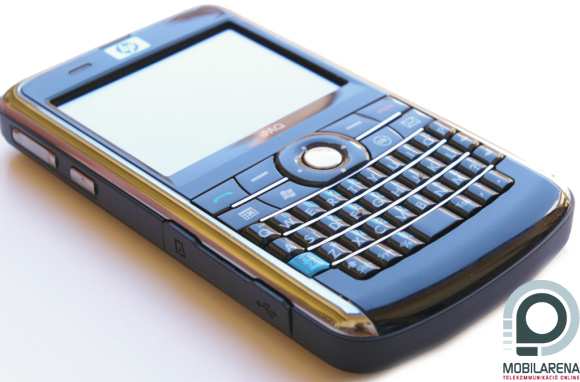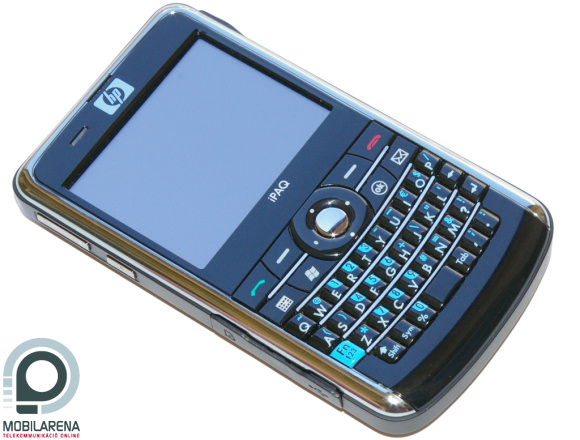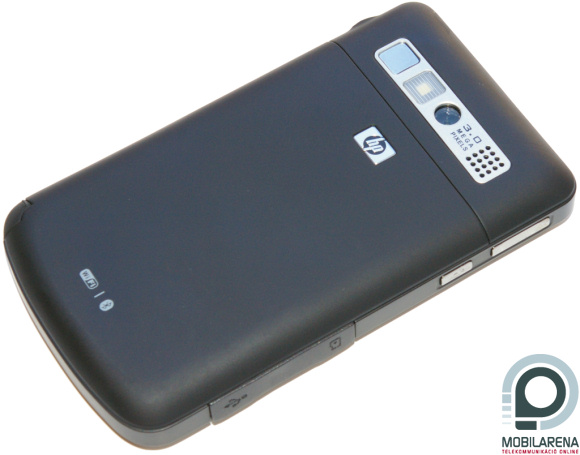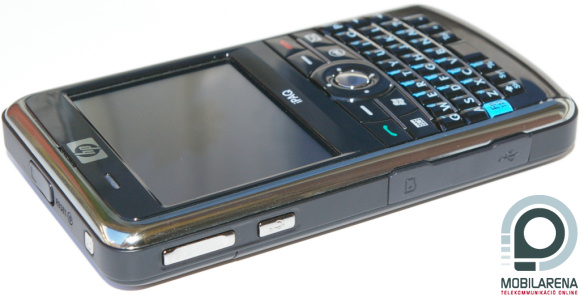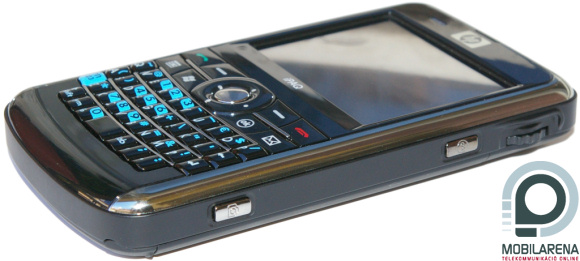Introduction, exterior
We’ve been waiting a lot for it. HP announced their new 900 series Pocket PC last September, but it only started shipping at the end of last month. There is not much known about the background to this, but the point is that the device is available and we had one for tasting, yet again from SpeedShop. It came in a white box and it shipped with a charger, a data cable and a stereo headset.
The manufacturer built up it’s product portfolio very well. There is a cheap WM-based smartphone (514 Voice Messenger), two PDAs without telephony features (from the 100 and the 200 series), a fine high-end combo device (614c) and the subject of our current review, 914c, that is based on the BlackBerry series. It is a real business model with an advanced display, a QWERTY keyboard and a demanding design. The front is black, it’s made of shiny, hard plastic, even looking at it makes me feel good. On the side there is a silvery band running along and the back is made of silky, rubber-like material, which provides a good grip. It’s a bit heavy (146 grams), it’s a bit large (113 x 64 x 16 mm), but many business handsets are like this.
The designers didn’t pay attention to a single thing. A small thing, that might sound insignificant, but it isn’t. There is a rubber cover on the left side of the handset, which protects the microSD slot and the miniUSB port from all external perils. Oh, I mean it would protect it if the designers would have been thinking about how such a thing works. The part covering the data connector stays at its place only until we take it out, for example in order to charge the phone. That’s it, after this no matter what we do the small piece of rubber will be hanging around there. This is a shame, a real, epic fail at such a high-class business device, not mentioning that it’s a great example for foolish design. Probably there won’t be many who will agree with me but I think that this is such a flaw that can destroy the overall image, even though the handset would be really fine. It’s a great luck that I took the pictures in the review before the first charge, after this I had to get used to the situation pictured below (pay attention to the lower part, as the memory card slot’s cover can be plugged back).
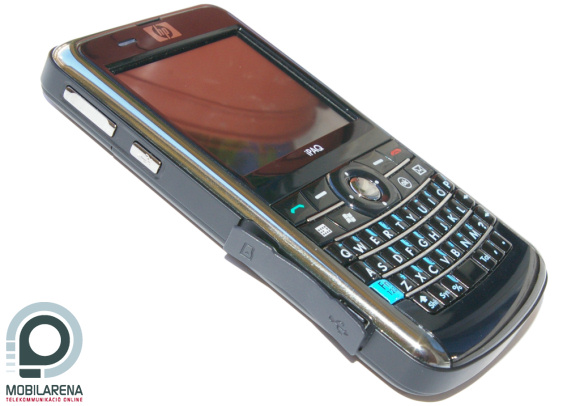
[+]
After the first charge. The rubber cover was somewhat still at its place here...
It’s probably not very good to start describing a product this way, but I just couldn’t accept such a design flaw, moreover at such a handset, which would practically be fine from every other point of view. On top, besides the status LEDs we can see the phone speaker, disguised as an HP logo, while under this we can see the landscape QVGA display below it, with a diagonal of 2.46”. Yeah, it’s quite small; this is the downside of this design. At about the center we find the main controls, which include eight keys and the five-way d-pad, which are really easy to use. The QWERTY keyboard with 37 keys is on the bottom, which basically provides a comfortable typing method, the only problem with it that the blue Fn key hardly reacted to presses, I can say that I had to press it really hard in order to make it function. Entering special characters is done rather easily, after pressing the desired key we just have to press the Sym button.
The back is not spectacular, I think that it perfectly matches the phone’s overall external design. On the top we can see the 3 megapixel autofocus camera and its accessories (flash and mirror), along with the handsfree speaker. The not too large HP logo is below this, while on the bottom we can see two other logos, which attract attention to the handset’s data communication features. The stylus is in the lower left corner, it’s telescopic, but even in a closed state it’s larger than at most other handsets when opened – so it’s really large which makes it very easy to use.
The power button is on the top, along with the reset gap and the external antenna’s connector, which is also protected by a cover – interestingly this is much, much better then the previously mentioned one on the side. On the left we can observe the volume control keys, the sound recorder’s hotkey and the already mentioned rubber cover.
There is nothing on the bottom, while on the right there is the camera’s exposure key, the OK button and the jog-dial, which is a bit hard to press, but it’s good that we have one.
Hardware, operating system
iPAQ runs Windows Mobile 6.1 Professional as an OS, while its heart is a 416 MHz Marvell PXA270 CPU, which is a bit outdated, as although it’s a fast and powerful chip, it’s not the best in terms of energy saving. RAM is 128 MB large, and ROM is 256 MB, we have 75 MB for running programs and about 100 for storing data, storage can be expanded with a microSD card. We have a separate drive (iPAQ File Store), which is 25 MB large.
In terms of speed there is nothing wrong with the handset, even small slowdowns were rare. Applications launched in a moment, scrolling is continuous, so we have nothing to complain about. Pocket PC Mark results tell the same – VsBenchmark didn’t run unfortunately, probably because of the landscape screen that cannot be rotated.
| Pocket PC Mark v1.03 | ||
| Dhrystone Benchmark (CPU) | 162.60 MIPS | |
| Whetstone Benchmark (CPU) | 5.24 MWIPS | |
| Memory Benchmark | 571.17 points | |
| File system Benchmark | 85.28 points | |
| Graphics Benchmark | 203.09 points | |
The results are just as expected, practically all are a strong medium. Marks for the CPU test are appropriate for the chip’s capabilities, memory and file system scores are also okay, while the score for the graphical test is exceptionally good.
Data transfer, calls, software
The phone supports both 2G and 3G networks, the GSM module is quad-banded (850/900/1800/1900 MHz). We can use GPRS, EDGE, UMTS and HSDPA for data transfer, this latter one has a speed of 7.2 Mbps. There is WiFi and Bluetooth support too, the previous supports standards 80.11b/g, while the latter is of version 2.0 and of course has stereo sound support (A2DP). The miniUSB connector’s version number is the same.

I had no problems during phone calls, there was nothing wrong with voice quality either. Signal strength was also all right, the handset worked fine when switching between 2G/3G networks too. All voice call software are the default one, which is no problem at all in case of a Windows Mobile Pocket PC, as Outlook does its job perfectly. We can store contacts in the phonebook until there is free memory and there are tons of extra fields. Messaging is also great, the phone has no problems with multimedia messages and the email client supports authenticated IMAP servers and attachments. There is a special feature: we can answer incoming mail with voice messages, which are recorded and transferred in MP3 format.

It might be familiar from other HP handsets that we have some special software, and the situation is the same in case of 914c too. First we have Google Maps and Google Search, and we can find other fine stuff in the Start menu. ClearVue PDF is default for any business model, just like Remote Desktop Mobile and Java. We also have an app for wireless printing (HP PrintSmart Mobile) a software for GPS positioning (HP iPAQ GPS QK Position) a fine task manager (surprisingly called Task Manager) and a Voice Commander. Thanks to the new Windows we have the new member of the Office family, OneNote Mobile, too. The Today screen is the factory default one, so it has no quicklaunch bar. There is nothing special or interesting in the Settings.

Multimedia, GPS
There is only one camera on the handset (so we can’t make video calls), but that has a resolution of 3 megapixels, it has autofocus and it has a LED flash to help it out in poor lighting conditions. Exposure, unfortunately, is very slow, pictures get blurred easily, which is also due to the fact that we don’t have to keep the phone landscape, and this is rather uncomfortable. Image quality, however, makes up for this, as the images have nice, bright colors, image noise is reduced, there is no trace of filtering, the dynamics range is rather high (you can’t see the clouds on the test pictures because there wasn’t any). There is no problem with macro photos either, only that the chance of blurring is even higher in this case, it took at least eight times to take the test picture you can see below, and it’s still not perfect.

The highest available resolution for pictures is 2048 x 1536 and 320 x 240 pixels for videos. There aren’t many settings, we can set white balance, JPEG compression, there is a self-timer, image sequencing (at 1.3 megapixel resolution) and that’s it.

In musical terms the handset isn’t very powerful, due to the lack of a standard jack output. The included headset has to be plugged in the miniUSB port. It is a really “plastic” thing, but it still has a rather good sound quality. In handsfree it’s still okay, there is no distortion even at a high volume. The player we have is Media Player, which is still quite weak in functions, but we can get things better by installing a third party software.
The GPS is an NMEA 0183, I had no problems with it, it established connection quickly and it was stable. I tried navigation with iGO 8, but that unfortunately didn’t work, due to the landscape screen.
Battery, summary
The battery is a fine example of the “oh my God!” category: it has a capacity of 1940 mAh. According to this, it’s really large; the 150 grams weight of the handset is due mostly to it. Uptime, however, will make up for this: 914c took it for three days, even though I’ve been talking a lot on it. This is an exceptionally great result for a Windows Mobile Pocket PC!
Summary: HP iPAQ 914c is basically an exceptionally good handset. There are no problems with the number of features, it’s okay on both the hardware and software sides, it’s fast, it looks good and the uptime makes us pass out. And it’s also relatively cheap, at the moment of writing this review it cost about €465 EUR. Still, that rubber cover I’ve discussed in detail at the beginning is something I just cannot understand: why did they have to ruin such a great handset with such a small annoyance? This might be an exaggeration for many of you, but that hanging piece of rubber annoyed me a lot, mostly because we’re talking about a nice, elegant phone. Unfortunately this is not a unique case, but a design flaw, so all future users should decide if they can go on living with it. If it doesn’t annoy you, then I can really recommend the phone.
 |
| HP iPAQ 914c Business Messenger |
Bocha
Translated by Szaszati
The handset has been provided by www.speedshop.hu. Thanks! To access the shop, please click here.
Specifications
| HP iPAQ 914c Business Messenger | ||
 | Technology | Quad-band GSM/GPRS/EDGE (850/900/1800/1900 MHz) +UMTS/HSDPA (850/1900/2100 MHz) |
| Operating system | Windows Mobile 6.1 Professional | |
| Size | 113 x 64 x 16 mm | |
| Weight | 146 grams | |
| CPU | 416 MHz Marvell PXA270 | |
| ROM/RAM | 256 / 128 MB (100 / 75 MB free) | |
| Display | 2.46” diagonal, 320 x 240 pixels resolution, 16 bit color depth touchscreen | |
| Expandability | microSD | |
| WiFi | 802.11b/g | |
| Infra / Bluetooth | none / 2.0 (A2DP too) | |
| GPS receiver | NMEA 0183 | |
| Audio | microphone, mono speaker | |
| Camera | 3 megapixels, autofocus | |
| Battery | 1940 mAh changeable Li-Ion | |
| Other | HP software, QWERTY keyboard | |
